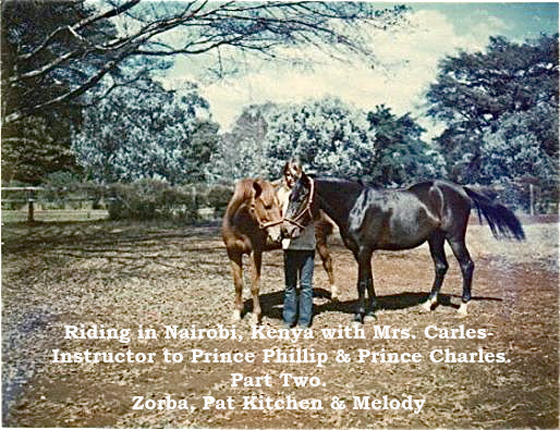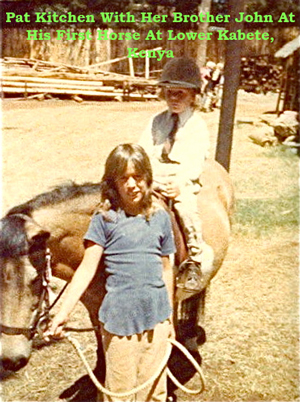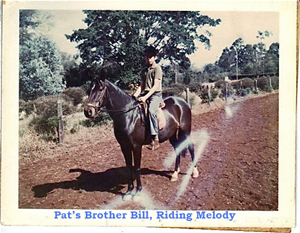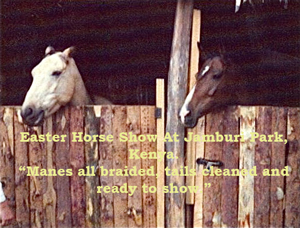Riding in Nairobi, Kenya with Mrs. Carles- Instructor to Prince Phillip & Prince Charles. Part Two.
by Pat Kitchen

I was dressed correctly, horse was groomed and tacked up and I had mastered getting on and off a horse properly. I was ready to ride, finally!
But we still did not really ride. Now we were to learn how to hold the reins... I think at this point, I had decided that riding was just not for me. I knew how to properly groom and tack up a horse, how to get on and off. I had even learned how to fall off properly. Bit I was still not riding, really riding. This is not what I envisioned, not even close. I had gone from grabbing a horse to ride at a friends hacienda in Ecuador to this.
'The Holding the Reins' lesson began: Reins would be picked up, and starting at the bottom of your hand, come out at the top with the reins falling to the left (or inside) over your thumb. Again, your pinky finger controlling the reins; to maintain light contact your pinky would ever so lightly move with the horse.
This is where Mrs. Carles started to compare American riding and “proper English style”. Americans, she would say, keep reins between ring finger and pinky. She said that there was no way to keep light contact with the horse if the reins holding the reins this way. Bottom of our hands were to be just above the pommel... not too high, not too low. Light contact with the reins. I don’t remember her talking about, forward seat, dressage seat, hunter/jumper seat. For her, it was a balanced seat.
From sitting deep, long stirrups (stirrup iron hitting just below ankle bone), to jump stirrups which had to be shortened about two holes, shorter but not too short. We were instructed to sit up straight and do not lean forward in any way. Americans she said rode leaning too far forward and with reins too long. She told us, "That look makes you look as if you were going to be sick, and with reins that long you would not be able to maintain contact with horse's mouth."
Head up, heals down, toes forward and not turned outward at all. Toes should be in line with your knees, if you look down and could see your toes they were too far forward; that meant you were not gripping properly. Also in line should be head, shoulders, hips and heels.
Now, we were on the horse, holding the reins appropriately, stirrups acceptably measured, girths secure, bottoms tucked and square in the center of the saddle. Sitting up straight we actually started to walk!! And walk is all we did that day. Balance, now we needed to make sure we were balanced.
Our lessons never had more than 3 people at a time, though others were invited to watch. There were no time limits, if there was we would have run out of time before we ever got on! She would have a plan for the day and we would stay until we got it right.
Mrs. Carles had grooms who would lead us around the riding ring, these wonderful men would even run next to the horse when we trotted, but trotting was not to happen on our first day of riding. The grooms would lead us; because she wanted to make sure we did not hurt the horse’s mouth. She did not want anyone to fall and get hurt. We did not want to fall because that would mean we would have to get back on. But I think , for the most part, she did not want us to hurt the horses’ mouths.
Walking around on a horse, even walking, meant I was heading in the right direction and before too long I would be galloping about. Sadly, this was not to be... At least not yet.
Probably, just so we did not get too frustrated (and bored); she was going to let us trot. But not before she told us how she wanted us to position our legs.
It was head, shoulders, hips and heel. These should all line up. Looking down, we should not be able to see our toes and the toes should be pointed straight not off to the side “as Americans do”, heels down. Oh, and our backs straight and relaxed. The knees firm against knee pads, calves of our legs not touching horse's sides. Keeping enough weight in the stirrup irons (set at the ball of our feet, no more no less). We were not to rely on our stirrups because should we lose one we would most likely fall off. If we gripped with our knees losing a stirrup would not be a problem.
Backs straight, head up, heels down, toes pointing forward and gripping with our knees we started to trot. The sitting trot first. If we were gripping properly and our heels were down our lower leg should not move. Our bottoms were not to come out of the saddle because she felt that we needed to stay as close to the horse as possible so that we were be able to feel the horse think, and be able to predict his next move. To get the horse to trot, we were instructed to sit deep and put a bit more pressure on your knees, using a slight touch with your calves if absolutely necessary. She would stand behind us as we trotted. Even after all these years, I can still hear her high pitched screech, “Pa-tty I can see daylight”, for a little lady she sure had a booming voice.
Now I was ready for the rising trot (posting as Americans called it). Rising trot is a faster pace than sitting trot. Her horses were trained to know that if you sat deep during a sitting trot and applied more pressure with your knees they would pick the pace up a bit. We learned from the very beginning that we should come down with the outside leg; she said that otherwise we could throw the horses off. We were to barely come off the saddle; unlike “Americans who came up far too much and pushed their hips forward in a disgusting manner”. Still we were to keep as much contact with the horse as possible.
Much to her disappointment I am sure, I never was able to master keeping my heels down, but had no problem gripping with my knees, keeping my butt tucked and my back relaxed. I sat deep, my legs and hands were quiet and she was happy enough with that.
 Happy day! Now we would canter. Horses and riders properly turned out. We mounted up. We were to learn to go from rising trot to canter. Sitting deep, pressure from knees and slight touch of calves into canter. Legs quiet, butt tucked and in the saddle and off we went. We learned to move with the horse. From the very beginning we were taught the proper lead. Horses should always lead with inside foreleg. To do this, pressure came from outside leg, just behind the girth (have to admit over the years I did forget this part and had to ask), and ever so light touch on inside rein. If we were sitting deep and moving with our horse, we should be able to feel which leg he was leading with and make necessary corrections immediately. There was no learning curve. It was done correctly or not at all, which is probably why after forty years I can still remember what she taught us.
Happy day! Now we would canter. Horses and riders properly turned out. We mounted up. We were to learn to go from rising trot to canter. Sitting deep, pressure from knees and slight touch of calves into canter. Legs quiet, butt tucked and in the saddle and off we went. We learned to move with the horse. From the very beginning we were taught the proper lead. Horses should always lead with inside foreleg. To do this, pressure came from outside leg, just behind the girth (have to admit over the years I did forget this part and had to ask), and ever so light touch on inside rein. If we were sitting deep and moving with our horse, we should be able to feel which leg he was leading with and make necessary corrections immediately. There was no learning curve. It was done correctly or not at all, which is probably why after forty years I can still remember what she taught us.
FUN AND GAMES
Mrs. Carles had games we could play on horseback after lessons. We learned to play polo. Which I could take or leave. My favorite was a game called 'Fox-in-Tail,' that is much like Flag Football. We would take a fox tail with cloth attached and tuck it into the waist band of our jodphurs, then go as fast as we wanted. We moved in and around trees at speed. I have to admit one day I made contact with a tree limb and off I came, landing on my feet, THEN I fell down. I had hurt my knee, but no matter, there was no blood, no obvious broken bones... I was to dust myself off and get right back on and prepare myself for what was coming next. Yes, it was fun and games, but I was never lose track of what I was doing and where my horse was going. I sat on the sidelines for the rest of that day.
Eventually we moved on to jumping. Starting with cavaletti and eventually moving up to water jumps. I was now addicted to going fast and jumping. Dressage just didn’t fit into what I wanted to do, but Mrs. Carles was to have none of that. Collecting my horse, walking white center lines, doing circles the proper way, pivoting, four point stop, flying changes, extending trot and canter, vs going fast and jumping? To me there was no comparison between going fast/ jumping and dressage. Dressage was just plain boring. But I did it, 4 times a week I did it, even more when I was training for a show.
Another fancy thing I was just not into... showing. For me it served no purpose (much like geometry). Why learn it if I wasn’t going to use/do it. Well, Mrs. Carles decided I was going to do it, like it or not. With showing came Pony Club and Gymkanas.
Zorba, my go fast and jump horse, was not a dressage horse, and he had grown just a bit too much and at 14.3 h.h. I could not show him. So Mrs Carles told my parents I needed a dressage pony which she had already picked out and all we had to do was get her. Another Anglo Arab, Tara was a dark bay dressage pony. I was finally where Mrs. Carles felt I should be and I have to admit I was having fun. During one lesson she asked us if we wanted to try something different. We were given the option to just do the same old thing, learn to drive or ride side saddle. I think she was quite pleased when I chose side saddle. The saddle was weird looking and getting on was a chore. She did let one of her grooms help me on. It was actually quite fun. I really liked it. It wasn’t nearly as difficult as I thought it would be.
Saying Good-bye to Mrs. Carles.
These many years later I appreciate that I learned dressage as it has helped me with my horse Zeus. When I first got Zeus, he would fight me tooth and nail. He was not being mean, but he was fighting me. He is an OTTB, who at some point had serious dressage training. If I sat deep and used my legs I could do figure eights with just my legs, and if I stopped sitting deep we had a quiet 'Whoa.' Sitting deep and with a click with my tongue and he would pick up his pace.
I am fortunate, that I was able to talk to Mrs. Carles and tell her about Zeus and how after all this time, everything she drilled into my head, was still there. She was quite pleased. Sadly, September 2013 at the age of 89, Mrs Carles passed away at her home in Lower Kabete Kenya.
After reading her obituary from the Kenya Horse Club Magazine I realized how many of us adored and how many more feared Mrs. Carles. There was her way and there was the wrong way…… and we all knew it. There was a lot of power in that little lady and I have come to realize that she knew it too.
Mrs. Carles (aka Felix) was a blonde cheeky lady, who was always perfectly turned out and always in the show ring for the In Hand, Hacks or Riding Horse Classes.
 She was never without a fresh gardenia in her jacket buttonhole and was the ultimate show girl. What a professional. The horses she entered were always immaculately turned out. Not a hair out of place and well behaved, usually black. I can remember Melody and Querida. Melody was my brother Bill’s horse. Mrs. Carles took in Melody and used her as a lesson horse when we left Kenya.
She was never without a fresh gardenia in her jacket buttonhole and was the ultimate show girl. What a professional. The horses she entered were always immaculately turned out. Not a hair out of place and well behaved, usually black. I can remember Melody and Querida. Melody was my brother Bill’s horse. Mrs. Carles took in Melody and used her as a lesson horse when we left Kenya.
It was always Felix’s groom who won the Groom's Class. One thing I remember well is that Felix always had a pocket full of treats that she would give to all. After show classes had taken place, it was always a privilege to be asked to lunch by Felix. Down one would go to her stable and she would open up the back of her car to reveal first and foremost the most beautiful Alsatian dog. Then out would come the picnic hamper and what a treat it was. Such an array of goodies, one had to be careful if one was going to ride in the afternoon as one could easily over do the eating at one of Felix’s picnic lunches!
Felix rode dressage but had trouble remembering her test so used to hum a song she had made up to help her remember her way.

She was obsessed with horses, later in her life after she was no longer able to ride she took in old retired horses, as she could not bear the thought of not having horses around. She was very generous with her time and never said no to helping out at shows, giving her time freely teaching young riders to ride. Those of us that persevered, her teachings are ingrained in our brains and we are the better for it. To Mrs. Carles, If you were not trained in dressage, you were not properly trained.
On occasion, Mrs Carles would be at Pony Club as an instructor. When we knew she was going to be there we would be up all night. It was times such as these when I was grateful to have cleaned so much of her tack I could whiz right through it without cutting corners. I had learned to just keep everything really clean not let anything build up. For Pony Club we used a pelham bit so I cleaned the curb chain the night before.
I don’t know how Pony Club is done anymore, but back in the day, Pony Club meant being “properly” turned out. Hairnet, black jacket, white button down shirt with peterpan collar (for us girls) and tie, jodhpur pants and boots, spit polished, clean helmets. Tack had to be clean, depending on your level, horses manes had to be pulled and braided. Mrs. Carles would undo a braid to make sure mane had been properly pulled before braided. At beginning of PC, she would pull on her white gloves and testing would begin….
Editor's Note: We recently received the following letter from a lady in Cape Town, South Africa in response to Pat Kitchen's article on Mrs. Carles in our last edition ( see archived articles Article 4). Amazingly the horse that Pat mentions above "Melody," her brother's horse, was one of horses that this lady lessoned on in Kenya. Catskill Horse Magazine truly does have a far reach in this small world. We were sad to have to relay the news of Mrs. Carles passing to her former student, but were glad to be able to put the to past student of Mrs. Carles in contact with each other to trot down memory lane together.
The Far Reach of Catskill Horse Magazine - South Africa
Catskill Horse received many letters each month and we are delighted to post this one from a lady in South Africa who was responding to our recent article from Contributing Writer Pat Kitchen, who wrote of her experiences riding in Kenya with Mrs. Carles. Before moving to Kenya, Mrs. Carles was responsible for training both Prince Philip and Prince Charles to ride in the United Kingdom.
The staff here were sad to have to inform Soraiya or Mrs. Carles passing, but were very pleased to able to connect both students that shared the same teacher in Africa. It's a small world, after all.
Hello Catskill horse,
This may be completely random, and a total long shot - but worth a try anyways
I'm trying to locate Mrs Carles - you wrote an article about her: http://catskillhorse.org/Vol4article6.html
I lived in Nairobi until I was 14 after which we moved to Canada, and I've sinced relocated several times. Am currently in Cape Town, SA - and taking riding lessons here...
I used to take riding lessons with Mrs Carles when I was just a young kiddo - and I often think of her - I used to ride her pony Honey, and then Melody, and entered loads of dressage and jumping competitions.
Not sure if she's around anymore - but if she is I would absolutely love to be in touch with her.
Any chance you have some contact information for her?
I can't tell you how much I would appreciate it
Thank you so much
Soraiya Verjee


